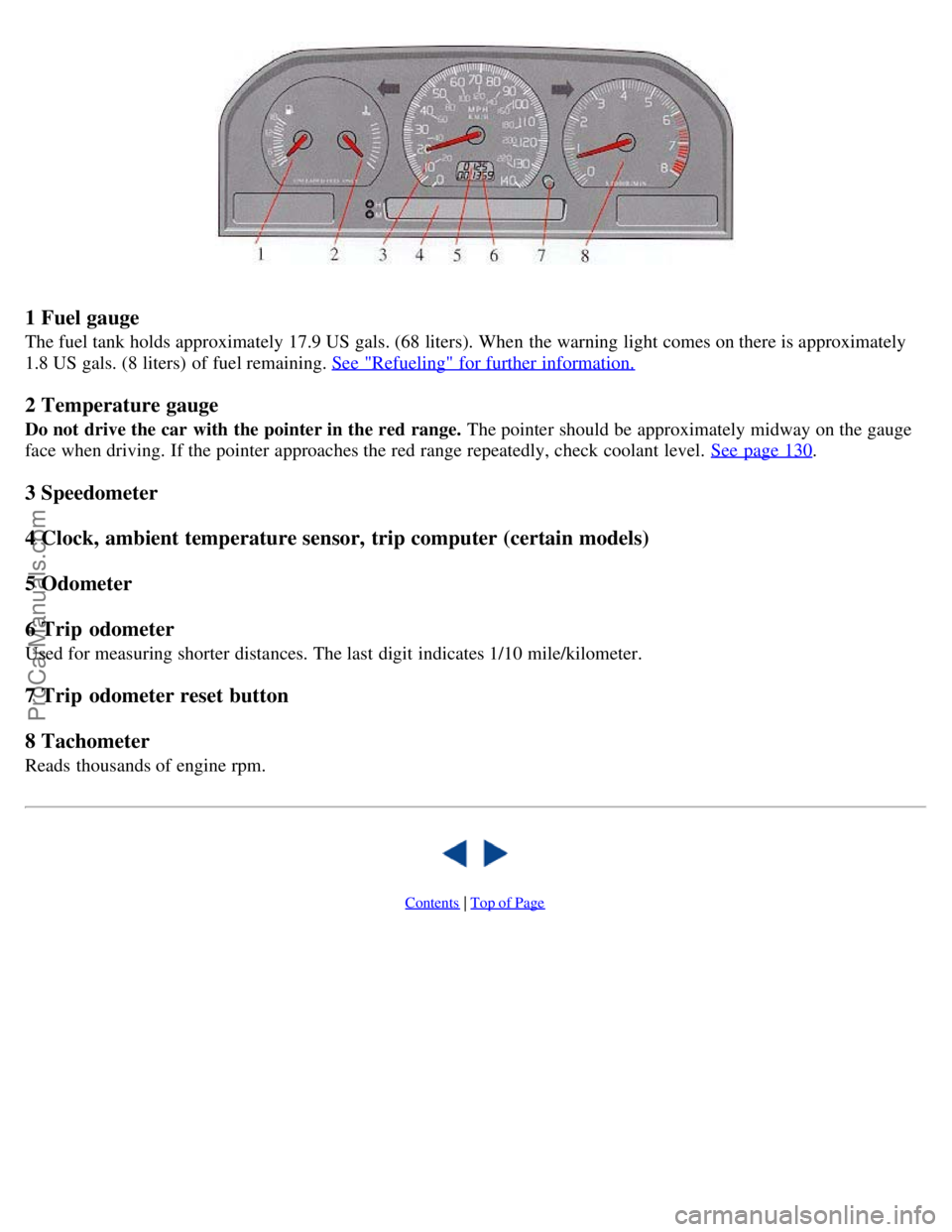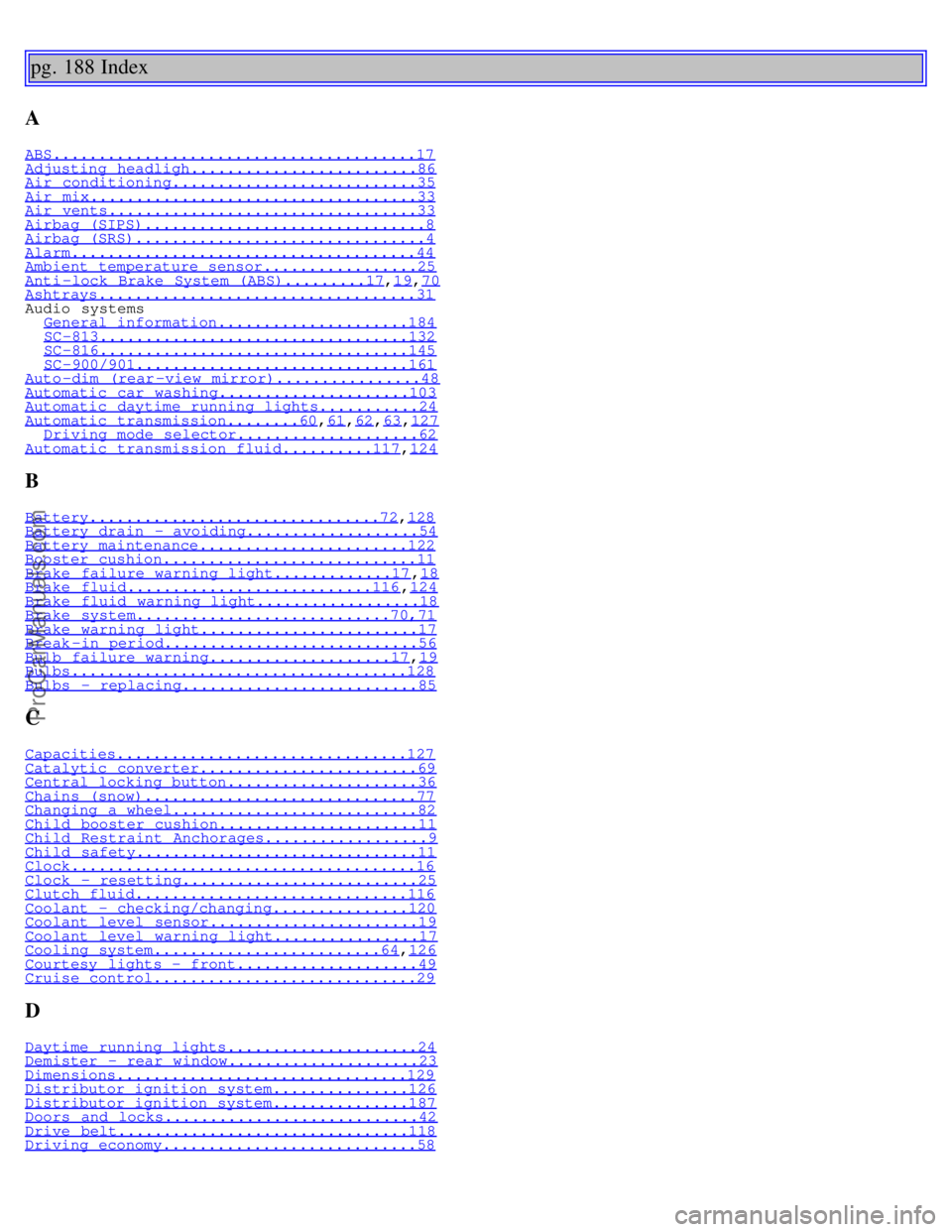clock VOLVO C70 1999 Owners Manual
[x] Cancel search | Manufacturer: VOLVO, Model Year: 1999, Model line: C70, Model: VOLVO C70 1999Pages: 39, PDF Size: 0.64 MB
Page 10 of 39

1 Fuel gauge
The fuel tank holds approximately 17.9 US gals. (68 liters). When the warning light comes on there is approximately
1.8 US gals. (8 liters) of fuel remaining. See "Refueling" for further information.
2 Temperature gauge
Do not drive the car with the pointer in the red range. The pointer should be approximately midway on the gauge
face when driving. If the pointer approaches the red range repeatedly, check coolant level. See page 130
.
3 Speedometer
4 Clock, ambient temperature sensor, trip computer (certain models)
5 Odometer
6 Trip odometer
Used for measuring shorter distances. The last digit indicates 1/10 mile/kilometer.
7 Trip odometer reset button
8 Tachometer
Reads thousands of engine rpm.
Contents | Top of Page
ProCarManuals.com
Page 17 of 39

Fuels containing up to 10% ethanol by volume may be used.
Ethanol may also be referred to as Ethyl alcohol, or "Gasohol".
Ethers — MTBE
Fuels containing up to 15% MTBE may be used.
Refueling
The fuel tank is designed to hold approximately 17.9 US gal. (68 liters) with sufficient volume left over to
accommodate possible expansion of the fuel in hot weather. Be aware that the "usable" tank will be somewhat less than
the specified maximum. When the fuel level is low, such factors as ambient temperature, the fuel's "Reid vapor
pressure" characteristics, and terrain can affect the fuel pumps' ability to supply the engine with an adequate supply of
fuel. Therefore, it is advisable to refuel as soon as possible when the needle nears the red zone, or when the fuel
warning light comes on.
Fuel tank cover
The fuel tank cover (on the right rear fender) is locked and must be popped open using the control on the driver's door.
Open fuel filler cap slowly during hot weather conditions.
CAUTION:
Do not refuel with the engine running. Turn the ignition off or to position I. If the ignition is on, an incorrect
reading could occur in the fuel gauge.
After refueling, close the fuel filler cap by turning it clockwise until it clicks into place *.
Allow for fuel expansion by not overfilling the tank. Overfilling could also cause damage to the emission control
systems.
Avoid spilling gasoline during refueling. Gasolines containing alcohol can cause damage to painted surfaces,
which may not be covered under the New Vehicle Limited Warranty.
Do not use gasoline containing methanol (methyl alcohol, wood alcohol). This practice can result in vehicle
performance deterioration and can damage critical parts in the fuel system. Such damage may not be covered under
the New Vehicle Limited Warranty.
* If the fuel filler cap is not closed tightly or if the engine is running when the car is refueled, the Malfunction
Indicator Lamp may indicate a fault. However, your vehicle's performance will not be affected. Use only Volvo
original or approved fuel filler caps.
Contents | Top of Page
ProCarManuals.com
Page 22 of 39

Chapter 6 - In case of emergency
pg. 81 In case of an emergency
In case of an emergency
Even if you maintain your car in good running condition, there is always the possibility that something might go wrong
and prevent you from driving, such as a punctured tire, blown fuse or bulb, etc. For additional information, see section
"ON CALL Road Assistance".
Wheel changing
82-83
Spare tire84
Replacing bulbs85-90
Replacing fuses91-93
Installation of accessories94
Replacing wiper blades95-96
In case of emergency97
pg. 82 Wheel changing
Loosen wheel bolts
Changing a wheel
The spare wheel is located under the carpet on the trunk floor. The jack and crank are secured in the wheel recess.
Engage the parking brake.
Put the gear selector in (P)ark (automatic) or in Reverse (manual).
With the car still on the ground, use the lug wrench to loosen the wheel bolts 1/2 - 1 turn. Turn the bolts
counterclockwise to loosen.
Fold out the crank handle on the jack by pressing the nob on the handle downward. To attach the jack, refer to the
illustration on the following page.
NOTE: To avoid excessive wear and the necessity of rebalancing, mark and reinstall wheels in same location and
position as before removal. To lessen the chance of imbalance, each wheel hub is equipped with a guide stud to ensure
ProCarManuals.com
Page 23 of 39

that a removed wheel can be reinstalled in its original position (as when changing over to winter tires/wheels).
CAUTION:
The car must not be driven with wheels of different dimensions or with a spare tire other than the one that came
with the car. The use of different size wheels can seriously damage your car's transmission.
pg. 83 Wheel changing (cont.)
Jack attachment
There is a jack attachment located in the center on each side of the car. Position the jack on the bar in the attachment
as shown in illustration A above and crank while simultaneously guiding the base of the jack to the ground. The base
of the jack must be flat on a level, firm, non-slippery surface. Before raising the car check that the jack is still
correctly positioned in the attachment. Raise the vehicle until both wheels on the side of the car where the jack is
attached are lifted off the ground. Unscrew the wheel bolts completely and carefully remove the wheel so as not to
damage the thread on the studs.
Installing the wheel
Clean the contact surfaces on the wheel and hub. Lift the wheel and place it on the hub. Make sure that you align the
wheel with the guide stud on the wheel hub prior to installation. Install the wheel bolts crosswise (see illustration) and
tighten by turning lightly clockwise. Lower the vehicle to the ground and alternately tighten the nuts to 81 ft. lbs. (110
Nm). Install the wheel cap (where applicable).
Correct tightening order for wheel bolts
WARNING!
The jack's attachment must engage the bar in the jack attachment (A). The car's weight must not rest on the jack's
attachment (B).
Be sure the jack is on a firm, level, non-slippery surface.
Never allow any part of your body to be extended under a car supported by a jack.
Use the jack intended for the car when replacing a wheel. For any other job, use stands to support the end of the
car being worked on.
Apply the parking brake, select position P (automatic transmission) or Reverse gear (manual transmission).
Block the wheels standing on the ground, use rigid wooden blocks or large stones.
The jack should be kept well-greased.
ProCarManuals.com
Page 35 of 39

pg. 188 Index
A
ABS........................................17Adjusting headligh.........................86Air conditioning...........................35Air mix....................................33Air vents..................................33Airbag (SIPS)...............................8Airbag (SRS)................................4Alarm......................................44Ambient temperature sensor.................25Anti -lock Brake System (ABS).........17, 19,70Ashtrays...................................31Audio systems
General information.....................184
SC-813..................................132 SC-816..................................145 SC-900/901..............................161Auto -dim (rear -view mirror)................48Automatic car washing.....................103Automatic daytime running lights...........24Automatic transmission........60,61,62,63,127 Driving mode selector....................62Automatic transmission fluid..........117,124
B
Battery................................72,128Battery drain - avoiding...................54Battery maintenance.......................122Booster cushion............................11Brake failure warning light.............17,18Brake fluid...........................116,124Brake fluid warning light..................18Brake system............................70,71Brake warning light........................17Break -in period............................56Bulb failure warning....................17,19Bulbs.....................................128Bulbs - replacing..........................85
C
Capacities................................127Catalytic converter........................69Central locking button.....................36Chains (snow)..............................77Changing a wheel...........................82Child booster cushion......................11Child Restraint Anchorages..................9Child safety...............................11Clock......................................16Clock - resetting..........................25Clutch fluid..............................116Coolant - checking/changing...............120Coolant level sensor.......................19Coolant level warning light................17Cooling system.........................64,126Courtesy lights - front....................49Cruise control.............................29
D
Daytime running lights.....................24Demister - rear window.....................23Dimensions................................129Distributor ignition system...............126Distributor ignition system...............187Doors and locks............................42Drive belt................................118Driving economy............................58
ProCarManuals.com